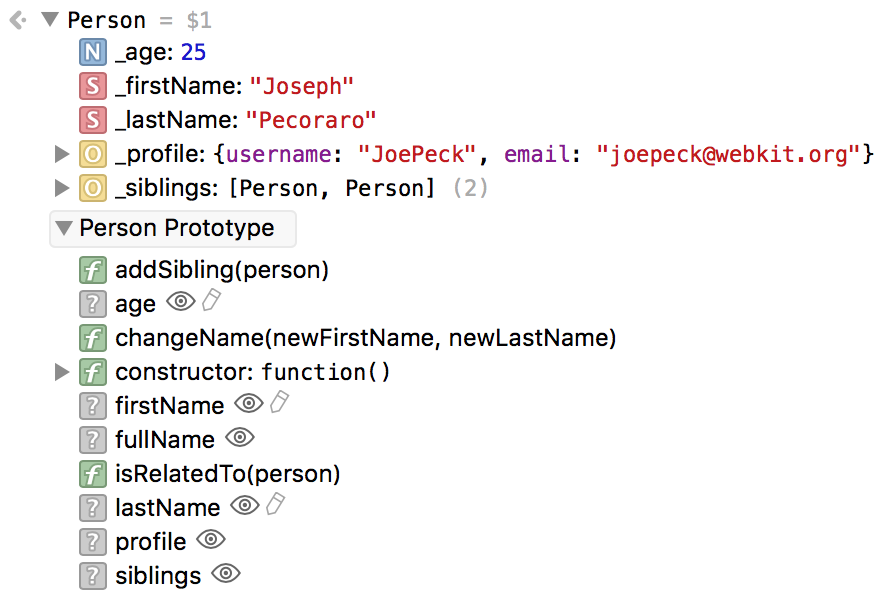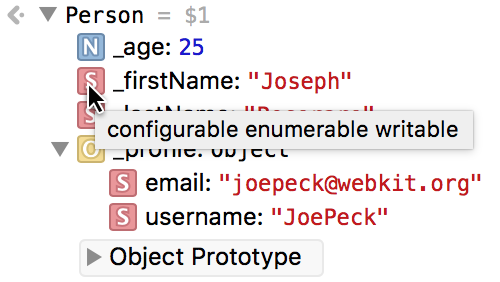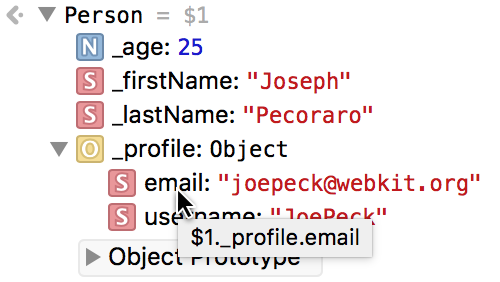Web Inspector Console Improvements
The console is an essential part of Web Inspector. Evaluating expressions in the quick console is one of the primary ways of interacting with the inspected page. Logs, errors, and warnings emitted from the page show up in the console and exploring or interacting with these objects is a given while debugging. We recently improved both the Console and Object views in Web Inspector to make it more powerful and fun to use. Our main focus was getting quicker access to useful data and modernizing it to work better with the new changes in JavaScript.
Basics – Object Previews, Trees, and $n
Object previews allow you to see the first few properties without needing to expand them. You’ll notice that each evaluation provides you with a “$n” debugger variable to refer back to that object later. These special variables are known only to the tools, so you won’t be cluttering the page with temporary variables. $0 still exists and refers to the current selected node in the DOM Tree.

When expanded, the full object tree view cleanly separates properties and API. Again, we use object previews where possible to reveal more data at a glance. The icons for each property correspond to the type of the value for that property. For example, in the image below you’ll see properties with number values have a blue N icon, strings with a red S, functions a green F, etc. The icons give objects a visual pattern, and makes it easy to visually find a particular property or an unexpected change in the normal data an object holds.

Supporting New Types
Web Inspector has always had great support for inspecting certain built-in JavaScript types such as Arrays and DOM types like Nodes. Web Inspector has improved those views and now has comprehensive support for all of the built-in JavaScript types. This including the new ES6 types (Symbol, Set, Map, WeakSet, WeakMap, Promises, Classes, Iterators).

WebKit’s tools are most useful when they show internal state of objects, known only to the engine, that is otherwise inaccessible. For example, showing the current status of Promises:

Or upcoming values of native Iterators:

Other interesting cases are showing values in WeakSets and WeakMaps, or showing the original target function and bound arguments for bound functions.
API View
When expanding an object’s prototype you get a great API view showing what methods you can call on the object. The API view always provides parameter names for user functions and even provides curated versions for native functions. The API view makes it really convenient to lookup or discover the ways that you can interact with objects already available to you in the console.

As an added bonus, if you are working with ES6 Classes and log a class by its name or its constructor you immediately get the API view for that class.
Interactivity
Object trees are more interactive. Hover a property icon to see the property’s descriptor attributes. Hover the property name to see the exact path you can use to access the property. Getters can be invoked, and their results can be further explored.


Context menus also provide more options. One of the most powerful features is that with any value in an Object tree you can use the context menu and select “Log Value” to re-log the value to the Console. This immediately creates a $n reference to the live object, letting you interact with it or easily reference it again later.
Console Messages
Console messages have also had a UI refresh, making logs, errors, warnings, and their location links stand out more:

Feedback
These enhancements are available to use in WebKit Nightly Builds. We would love to hear your feedback! You can send us quick feedback on Twitter (@JosephPecoraro, @xeenon), file a bug report, or even consider contributing your own enhancements!